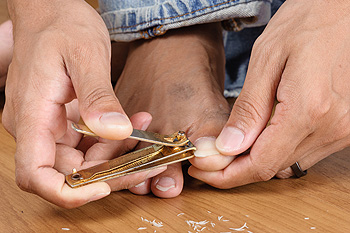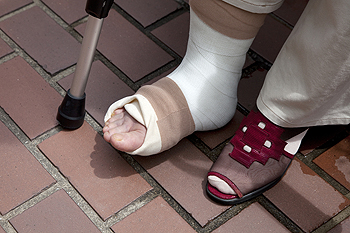 It is easy to forget to take care of your feet in the warmer weather. In the summer, your feet are more likely to be exposed to the sun and hot surfaces, which may cause them to become dry and rough. One of the best things you can do for your feet is to eliminate the dry skin cells. This can be achieved by exfoliating your feet once a week. This process will leave you with feet that are soft and renewed. Afterward, you should use a moisturizer on your feet to make sure they stay hydrated throughout the day. There are several types of pumice stones available for sale, and it’s suggested to have one in shower that can be used frequently. Adequately moisturizing your heels are crucial because the heels bear the majority of the weight. The heel also has a thick layer of skin protecting it, and this skin is less penetrable which makes moisturizing difficult. Therefore, it will take more effort to ensure that moisture is locked into the skin.
It is easy to forget to take care of your feet in the warmer weather. In the summer, your feet are more likely to be exposed to the sun and hot surfaces, which may cause them to become dry and rough. One of the best things you can do for your feet is to eliminate the dry skin cells. This can be achieved by exfoliating your feet once a week. This process will leave you with feet that are soft and renewed. Afterward, you should use a moisturizer on your feet to make sure they stay hydrated throughout the day. There are several types of pumice stones available for sale, and it’s suggested to have one in shower that can be used frequently. Adequately moisturizing your heels are crucial because the heels bear the majority of the weight. The heel also has a thick layer of skin protecting it, and this skin is less penetrable which makes moisturizing difficult. Therefore, it will take more effort to ensure that moisture is locked into the skin.
Everyday foot care is very important to prevent infection and other foot ailments. If you need your feet checked, contact Dr. Morris Stribling from Foot Care of Central San Antonio. Our doctor can provide the care you need to keep you pain-free and on your feet.
Everyday Foot Care
Often, people take care of their bodies, face and hair more so than they do for their feet. But the feet are a very important aspect of our bodies, and one that we should pay more attention to. Without our feet, we would not be able to perform most daily tasks.
It is best to check your feet regularly to make sure there are no new bruises or cuts that you may not have noticed before. For dry feet, moisturizer can easily be a remedy and can be applied as often as necessary to the affected areas. Wearing shoes that fit well can also help you maintain good foot health, as well as making it easier to walk and do daily activities without the stress or pain of ill-fitting shoes, high heels, or even flip flops. Wearing clean socks with closed shoes is important to ensure that sweat and bacteria do not accumulate within the shoe. Clean socks help to prevent Athlete’s foot, fungi problems, bad odors, and can absorb sweat.
If you have any questions please feel free to contact our office located in Central San Antonio, TX. We offer the newest diagnostic and treatment technologies for all your foot and ankle needs.
Read more about Every Day Foot Care A broken foot is a painful and common foot condition to contend with. There are 26 bones in the foot, and the feet can generally withstand a considerable amount of pressure. A broken foot is typically the result of a fall, and you may notice immediate bruising and swelling. Symptoms from a severe break may include a portion of the bone extending through the skin or an open wound beginning to form that surrounds the affected area. If you are unable to walk on the foot or experience extreme tenderness, it’s advised that you seek immediate medical attention. Research has shown that it’s important to rest the foot by not walking on it, in addition to elevating the foot which may diminish the swelling. A diagnosis is determined, which often consists of having an X-ray performed and is typically the first step in the proper treatment of a broken foot. A cast is generally used to keep the foot stable while the healing process begins, and can last up to 6 weeks. A consultation with a podiatrist is recommended for a complete evaluation of your broken foot.
A broken foot is a painful and common foot condition to contend with. There are 26 bones in the foot, and the feet can generally withstand a considerable amount of pressure. A broken foot is typically the result of a fall, and you may notice immediate bruising and swelling. Symptoms from a severe break may include a portion of the bone extending through the skin or an open wound beginning to form that surrounds the affected area. If you are unable to walk on the foot or experience extreme tenderness, it’s advised that you seek immediate medical attention. Research has shown that it’s important to rest the foot by not walking on it, in addition to elevating the foot which may diminish the swelling. A diagnosis is determined, which often consists of having an X-ray performed and is typically the first step in the proper treatment of a broken foot. A cast is generally used to keep the foot stable while the healing process begins, and can last up to 6 weeks. A consultation with a podiatrist is recommended for a complete evaluation of your broken foot.
A broken foot requires immediate medical attention and treatment. If you need your feet checked, contact Dr. Morris Stribling from Foot Care of Central San Antonio. Our doctor can provide the care you need to keep you pain-free and on your feet.
Broken Foot Causes, Symptoms, and Treatment
A broken foot is caused by one of the bones in the foot typically breaking when bended, crushed, or stretched beyond its natural capabilities. Usually the location of the fracture indicates how the break occurred, whether it was through an object, fall, or any other type of injury.
Common Symptoms of Broken Feet:
Those that suspect they have a broken foot shoot seek urgent medical attention where a medical professional could diagnose the severity.
Treatment for broken bones varies depending on the cause, severity and location. Some will require the use of splints, casts or crutches while others could even involve surgery to repair the broken bones. Personal care includes the use of ice and keeping the foot stabilized and elevated.
If you have any questions please feel free to contact our office located in Central San Antonio, TX. We offer the newest diagnostic and treatment technologies for all your foot and ankle needs.
Read more about Causes, Symptoms, and Treatment for a Broken Foot A doctor that specializes in disorders of the foot is referred to as a podiatrist. This type of doctor typically treats foot conditions including hammer toe, bunions and ingrown toenails. They may also treat foot ailments caused by birth defects such as clubfoot and flat feet. Diabetic patients often notice sores on their feet, which may heal slowly, and this may be one of the first symptoms indicating this condition exists. Within this field, there are categories specific to the type of patient that is being treated. For instance, podiatrists who specialize in sports medicine typically treat athletes. Doctors who are skilled in advanced surgery may perform foot and ankle reconstruction, which may be a necessary option after an injury. If you have any questions regarding podiatry, please consult with your podiatrist.
A doctor that specializes in disorders of the foot is referred to as a podiatrist. This type of doctor typically treats foot conditions including hammer toe, bunions and ingrown toenails. They may also treat foot ailments caused by birth defects such as clubfoot and flat feet. Diabetic patients often notice sores on their feet, which may heal slowly, and this may be one of the first symptoms indicating this condition exists. Within this field, there are categories specific to the type of patient that is being treated. For instance, podiatrists who specialize in sports medicine typically treat athletes. Doctors who are skilled in advanced surgery may perform foot and ankle reconstruction, which may be a necessary option after an injury. If you have any questions regarding podiatry, please consult with your podiatrist.
If you are dealing with pain in your feet and ankles, you may want to seek help from a podiatrist. Feel free to contact Dr. Morris Stribling from Foot Care of Central San Antonio. Our doctor can provide the care you need to keep you pain-free and on your feet.
What is a Podiatrist?
A podiatrist is a doctor of podiatric medicine who diagnoses and treats conditions of the foot, ankle, and related structures of the leg. Your podiatrist may specialize in a certain field such as sports medicine, wound care, pediatrics, and diabetic care. Podiatrists have the ability to become board certified through training, clinical experience, and then taking an exam.
What Do Podiatrists Do?
On a daily basis, a podiatrist may perform the following activities:
It is very important that you take care of your feet. It’s easy to take having healthy feet for granted, however foot problems tend to be among the most common health conditions. Podiatrists can help diagnose and treat a variety of feet related conditions so it is crucial that you visit one if you need assistance.
If you have any questions please feel free to contact our offices located in Wilmington and Hockessin, DE. We offer the newest diagnostic and treatment technologies for all your foot and ankle needs.
Read more about What is a Podiatrist?
 A heel spur is defined as a bony protrusion that develops on the heel of the foot, and it may cause severe discomfort. Research has shown that calcium deposits may gradually form under the heels, resulting in the development of heel spurs. Other symptoms of this ailment may include an achiness that is felt in the heel for the majority of the day, sharp heel pain while standing especially in the morning, and the affected area appearing swollen and tender. There are several causes for heel spurs to develop, including an injury that may tear the membrane covering the heel, and strain to the ligaments that may weaken the soft tissue. Relief may be found by resting and elevating the foot which may reduce swelling, in addition to wearing cushioned shoes. A consultation with a podiatrist will aid further increasing your knowledge about heel spurs.
A heel spur is defined as a bony protrusion that develops on the heel of the foot, and it may cause severe discomfort. Research has shown that calcium deposits may gradually form under the heels, resulting in the development of heel spurs. Other symptoms of this ailment may include an achiness that is felt in the heel for the majority of the day, sharp heel pain while standing especially in the morning, and the affected area appearing swollen and tender. There are several causes for heel spurs to develop, including an injury that may tear the membrane covering the heel, and strain to the ligaments that may weaken the soft tissue. Relief may be found by resting and elevating the foot which may reduce swelling, in addition to wearing cushioned shoes. A consultation with a podiatrist will aid further increasing your knowledge about heel spurs.
Heel spurs can be incredibly painful and sometimes may make you unable to participate in physical activities. To get medical care for your heel spurs, contact Dr. Morris Stribling from Foot Care of Central San Antonio. Our doctor will do everything possible to treat your condition.
Heels Spurs
Heel spurs are formed by calcium deposits on the back of the foot where the heel is. This can also be caused by small fragments of bone breaking off one section of the foot, attaching onto the back of the foot. Heel spurs can also be bone growth on the back of the foot and may grow in the direction of the arch of the foot.
Older individuals usually suffer from heel spurs and pain sometimes intensifies with age. One of the main conditions spurs are related to is plantar fasciitis.
Pain
The pain associated with spurs is often because of weight placed on the feet. When someone is walking, their entire weight is concentrated on the feet. Bone spurs then have the tendency to affect other bones and tissues around the foot. As the pain continues, the feet will become tender and sensitive over time.
Treatments
There are many ways to treat heel spurs. If one is suffering from heel spurs in conjunction with pain, there are several methods for healing. Medication, surgery, and herbal care are some options.
If you have any questions feel free to contact our office located in Central San Antonio, TX. We offer the latest in diagnostic and treatment technology to meet your needs.
Read more about Heel Spurs